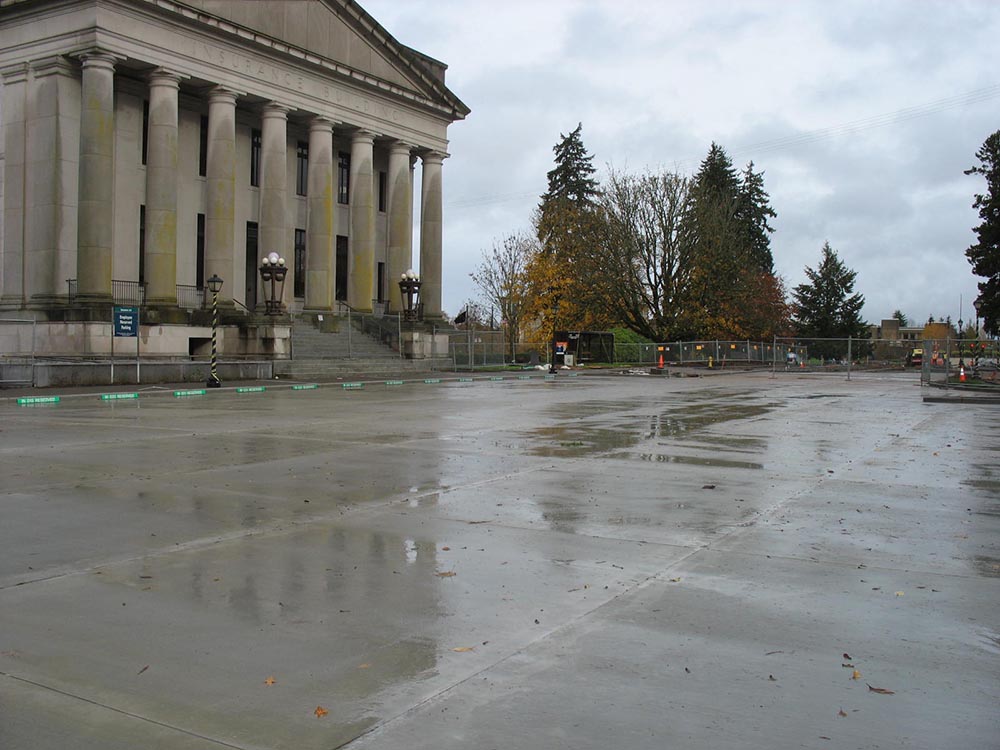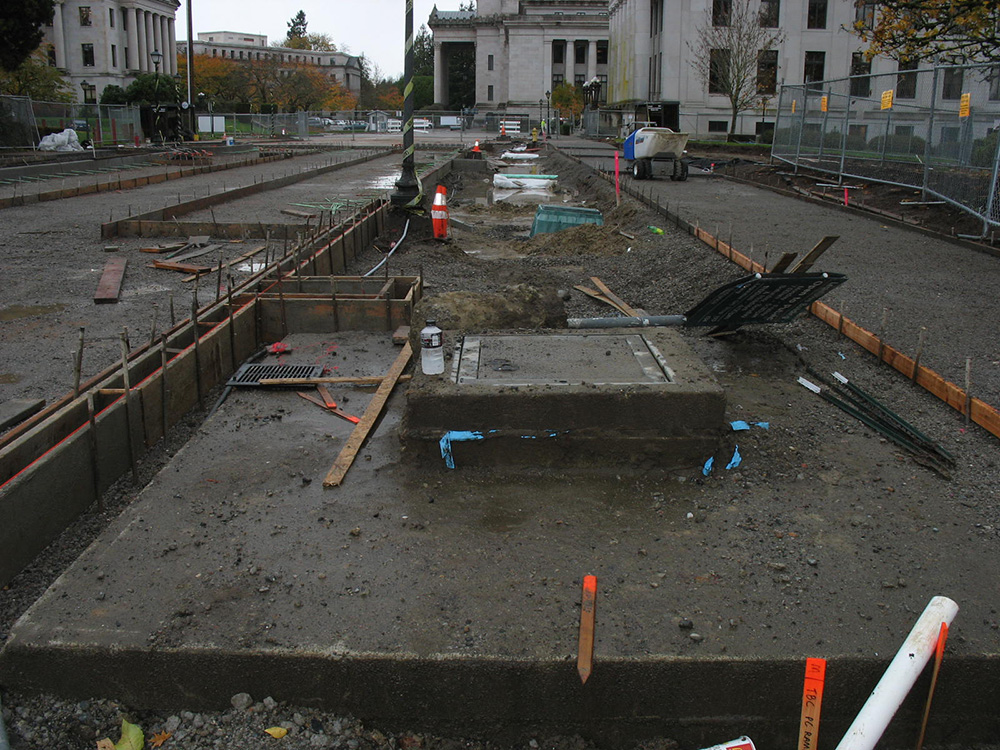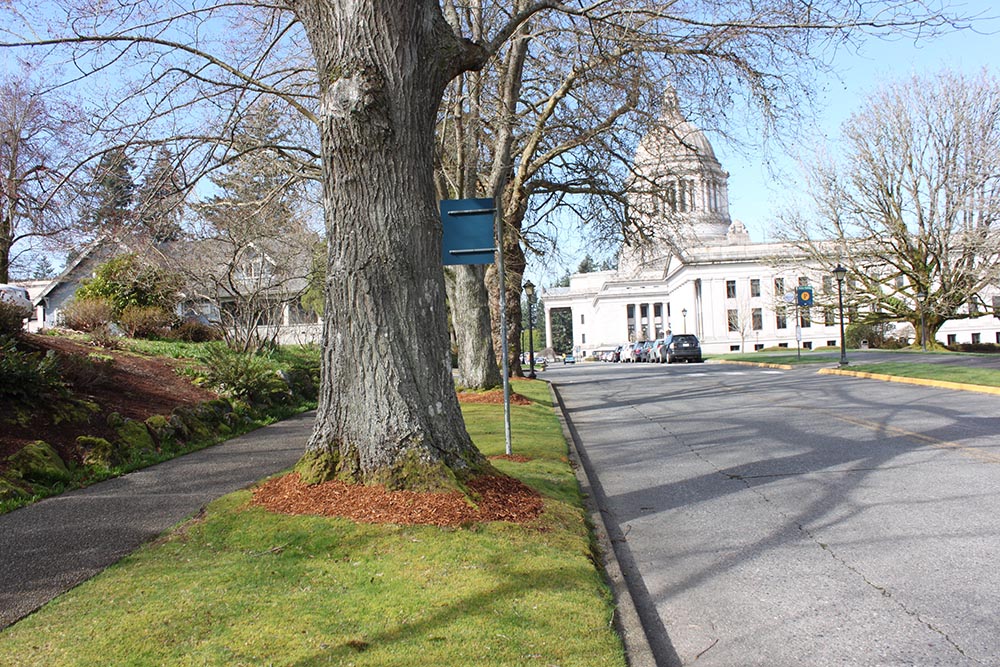Some people might think it is strange to think of work while cruising on the Caribbean. The blue sky and white clouds in front of the ship make the rainy days in the Puget Sound area thousands of miles away seem like faded photos. However, cruising on the sea for two straight days provides a lot of quiet time to think. While sitting on the balcony of our stateroom, the Sid Snyder Way project continually comes up in my mind. The excitement of winning the project, the intensive work in the last few months, and the surprises and frustration during construction replay in my head.
Bringing History to Life
Olympia Washington’s West Capitol Campus was originally designed about 80 years ago by the Olmstead Brothers, a well-known landscaping architect firm. But much of the Olmstead design had never been implemented. This is the first project to implement the Olmstead’s original design after 80 years.
Sid Snyder Way is a small street located at the West Capitol Campus. This two-lane, 750-foot street connects Capitol Way and the State Legislative Building. Nothing is unusual except that it is the gateway to the State West Capitol Campus, where the Legislative Building, the Temple of Justice, the Governor’s Mansion, and several other state government buildings are located. Because of its location, the project generated a lot of interest and attracted a lot of attention. The purpose of the project was to rebuild the street.
Time Was Not on Our Side
The project had a tight schedule. Reid Middleton’s team was selected to provide design and construction administration services in January 2014. The project owner, Washington State Department of Enterprise Services, required construction to be done before the legislative session begins in January 2015. One year to complete the project does not seem so bad. However, site investigations, including geotechnical exploration and topographic survey could not be performed until mid-April 2014 when the 2014 legislative session came to an end. To avoid performing earthwork during the wet weather season (for cost savings reasons), the street paving should be done by the end of October or early November 2014. These constraints shortened the project duration to approximately 8-1/2 months, including 3-1/2 months for construction, 1-1/2 months for bid & contracting, and 3-1/2 months for site investigation, design, and permitting. Everything has an accelerated schedule.
Given the tight time frame, planning and scheduling was essential for the success of the project with nearly every task on a critical path. Many tasks had to be performed out of regular design order. Schematic design was performed based on available documents while the geotechnical exploration and topographic survey were underway.
To smooth out and speed up the permitting process, Reid Middleton involved the City of Olympia, the authority that has jurisdiction, from the early phase of the project. The continual coordination and good working relationship with the City paid off. The permitting process went relatively smoothly, and the construction permit was received in time for project bidding and construction. Construction started in early August.
Unique Technical Challenges
Sid Snyder Way was built 80 years ago. Many of the underground utilities were installed at the time the road was built, and no major improvements have been done for decades. No one really knew what was buried underground and how the utilities connected. Due to budget and time constraints, a thorough site investigation could not be performed before design. Some surprises during construction were expected. But no one expected as many surprises as we encountered.
Questions (or RFIs) occurred during construction. Most of them had to do with unexpected underground utilities and latent site conditions. The sewer service line to the Legislative Building was found 45 feet north of the location indicated on the record drawings; some existing utility lines were buried shallower than normal and conflicted with proposed utilities; confusing utility connections had to be figured out and improved. Just to name a few items of investigation. Quick design revisions were required for these unexpected site conditions to keep construction moving.
The strangest thing encountered during construction was a curvy sewer main. When getting ready to install the new sewer main to replace an existing one near the Sid Snyder Way and Capitol Way intersection, the contractor noticed that the existing sewer main connecting two manholes did not run straight between the two manholes. However, exactly how the pipe ran between the two manholes was not known. Without knowing the exact routing of the existing sewer main, the replacement sewer main could not be installed because it might run into the existing main that needed to be kept in service during construction. A quick investigation had to be done to find out the existing main routing. Overnight, a video inspection of the sewer main mapped the location on the surface. To everyone’s surprise, the clay main curved away from the sewer manhole near the street center line to pick up three catch basin drains on the south side of the street and then curved back to the next manhole near the street center line. The two manholes were 300 feet apart. While the camera was tracking the pipe route, the team made wild guesses about the exact length of the pipe run. My guess was 310 feet, and I won!
Unknown utilities and latent site conditions were not the only challenge to the project. The West Capitol Campus is a busy place even when the legislature is not in session. Avoiding interruption to state government operations, maintaining parking spaces, and minimizing traffic interruption are big challenges to the project. In addition, visitors to the Capitol Campus, various demonstrations, organization gathering, graduation celebrations, and even weddings can all became challenges. The construction required a lot of communication and coordination among the contractor, design team, the project owner, and various state agencies.
Another element of the project was to replace two sections of high voltage power lines while avoiding any interruption to government operations. Replacement of the power lines required switching existing to temporary and then temporary to permanent, which required temporary outage to buildings at the campus, including the Governor’s Mansion. To avoid interruption to government operations, the work had to be done on weekends; however, on weekends the campus is not fully available to the construction crews. And when switching the power crossing the street to temporary, DES had to coordinate with multiple agencies. They negotiated with the Office of Financial Management to agree to finish their work by Saturday (due on the next Monday), so the power switching could be done on Sunday. To ensure a smooth run, an outage and switching rehearsal was conducted. On Sunday when the switching occurred, power was turned off building by building and then turned on building by building again. It went smoothly and as planned.
Nearing the Finish Line
This is the Sid Snyder Way project, fast paced and full of surprises and challenges. It was frustrating sometimes, especially during the underground utility installation when the construction crew ran into surprise after surprise. But the worst has passed, the project is approaching completion, and all we need is the cooperation of the weather. While sitting on a cruise ship and looking at the blue sea in the Caribbean, I wish the guys back in Olympia could have a few decent weather days so that the concrete street paving work can be finished in time.




